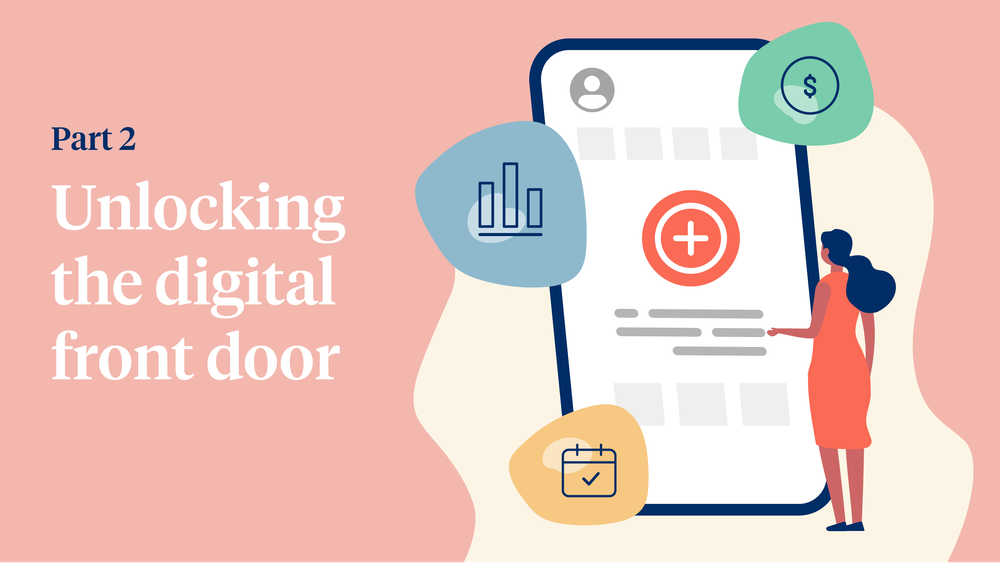Unlocking the Digital Front Door is a three-part blog series that explores how health systems can deliver meaningful digital patient experiences by choosing the right third-party solutions to optimize patient portal engagement. Read parts one and three now.
After years spent implementing your EHR, migrating newly-acquired entities to your system and eventually adding a patient portal, your organization has finally reached a steady-state period and has shifted strategic initiatives. You’re now prioritizing the digital front door as a means to differentiate your brand, retain patients and grow market share, because let’s face it, if you don’t do it, somebody else will.
But after putting your IT system to work, you’ve realized that the patient portal experience is suboptimal and that your EHR vendor’s capabilities are limited when it comes to driving meaningful engagement. Acknowledging that the portal isn’t the “end all be all” for all things patient engagement, you’re now asking: “How do I optimize my portal to deliver the best possible patient experience in line with consumer expectations without having to rip and replace?”
This is a common scenario at health systems and a major blocker toward realizing the digital front door vision. In order to fill patient portal user experience and functionality gaps today, you must look beyond your EHRs toward third-party, digital health solutions.
Reimagining the portal as a platform
Historically, it’s been challenging for digital health apps to integrate and exchange data with EHRs. As a result, implementations were painful, go-lives were often delayed and integrations were expensive to maintain. These negative experiences with digital health apps, commonly referred to as “point solutions,” have left healthcare leaders wary of exploring third-party options with questionable ROI potential (and rightfully so).
But in recent years, the big EHRs have started to embrace app culture and become better partners with vendor developers. More usable sets of APIs and app ecosystems like Epic App Orchard and Cerner Open Developer Experience (aka Code) App Gallery, as well as third-party integration vendors such as Redox, have enabled quicker implementations at a lower cost. While it’s certainly not as simple as clicking a button in an app store, more streamlined implementations are now possible.
With reduced barriers to integration, shorter implementation timelines and minimized security risks, healthcare organizations can regain control of their innovation roadmaps. If EHR vendors continue to invest in data interoperability and their third-party app ecosystems, we can expect to see the digital health landscape shift from being a fragmented collection of solutions to a “hub and spoke” model where EHR vendors deliver a majority of capabilities and are supplemented by niche products to fill gaps and augment those capabilities, resulting in a better experience for patients while improving the value of the capital already invested in the EHR.
While it’s understandable as to why some organizations may be apprehensive about shifting their digital strategy to this model, consider the following benefits of investing in third-party solutions:
1) Address specific patient pain points with user-obsessed solutions to improve patient engagement
Making a great product requires a hyper-narrow focus on a specific set of users and problem space, as well as continuous experimentation and iteration. It’s rare that we see an all-in-one solution do all the things it purports to do really well, and this is often due to the absence of this obsessive focus. We’ve certainly seen this with patient portals and as a result, the needs of patients are de-prioritized compared to the needs of the organization, and the UX suffers.
The reality is the experience of scheduling an appointment feels different than that of managing your medical bills. In the former workflow, patients access the portal by choice to begin to address a very specific healthcare need; in the latter, patients are asked to access the portal to pay a bill that they may or may not understand or be able to afford. If scheduling utilization is high and self-pay collection rates are low, it may be time to explore third-party solutions to facilitate a better healthcare payment experience.
Best-in-breed financial engagement vendors spend a considerable amount of time and effort trying to gain a deeper understanding of where users are emotionally and cognitively in the billing process, and design product solutions around specific problems.
For example, patients may mistakenly think that they are being double-billed when they receive professional and facility service invoices at different times following an inpatient stay; this could potentially result in disengagement and nonpayment. By including easy to understand explanations of what each of these service types entail and clearly labeling invoices as such in the digital experience, patients will feel more empowered to resolve these obligations.
2) Gain access to rich and actionable performance data to continually drive workflow improvements
Digital health vendors collect and analyze an immense amount of data to build better products and optimize performance. Many also offer user-friendly analytics and reporting tools that enable healthcare organizations to access and visualize data in an effort to identify opportunities for improvement.
While patient portals typically provide an aggregated view of KPIs related to account creation, lab result viewing and appointment scheduling, they do not offer the level of data visibility required to improve specific features and workflows and personalize the patient experience.
Likewise, portals are not offering the data analytics for healthcare payments needed to optimize patient collections performance. For instance, getting visibility into what the engagement funnel looks like (i.e., understanding the share of patients who made a payment after reaching checkout; share of patients who accessed the payment page after receiving a notification, etc.) can help you establish baseline metrics, illuminate areas of improvement and more quickly iterate on engagement tactics to drive better results.
3) Bring your legacy systems into the cloud to enhance the patient experience in real-time
One of the biggest barriers to patient portal engagement optimization is the fact that the EHRs and tethered patient portals most widely used by health systems are on-prem implementations, meaning that new product releases need to be physically installed on an annual or semi-annual basis. This prohibits EHR vendors from being agile, forward-thinking technology partners.
Most digital health apps on the market are cloud-based, which enables them to ship out new features, enhancements and experiments in real-time. EHR vendors require you to wait until next quarter’s release date to implement these types of improvements.
For example, curious to understand how modifying the frequency of sending billing reminders via email impacts payment rates today? There’s an app for that. Innovative financial engagement vendors with cloud-based platforms can swiftly design and implement an experiment around different email communication intervals and algorithmically optimize it.
Placing a bet on healthcare app culture
While we’re still far from seeing EHRs/patient portals evolve into platforms where developers can more easily build apps using APIs to the same extent that we’ve seen in other spaces (i.e., Amazon Web Services for tech startups or Stripe for payments), there has certainly been incremental momentum that makes exploring third-party solutions worthwhile. Early adopters of the hub and spoke model today stand to gain a competitive advantage in an industry that is slowly but surely moving in that direction.
Of course not all third-party digital health solutions stand on equal footing. In the final installment of this series, we will identify and discuss key factors to consider when evaluating vendors to ensure that your organization is delivering the most seamless and optimal patient portal experience possible.



